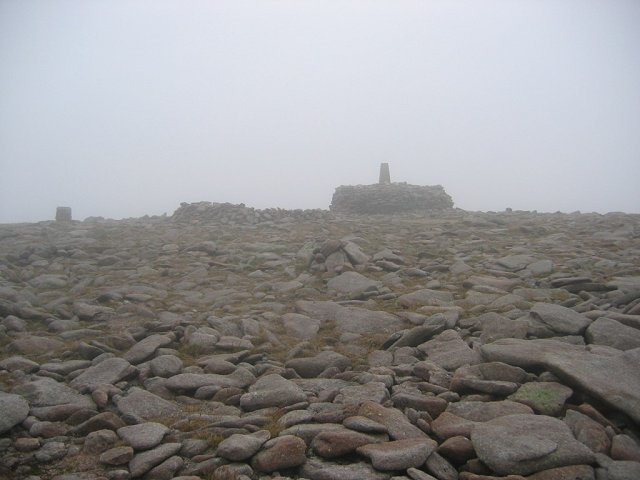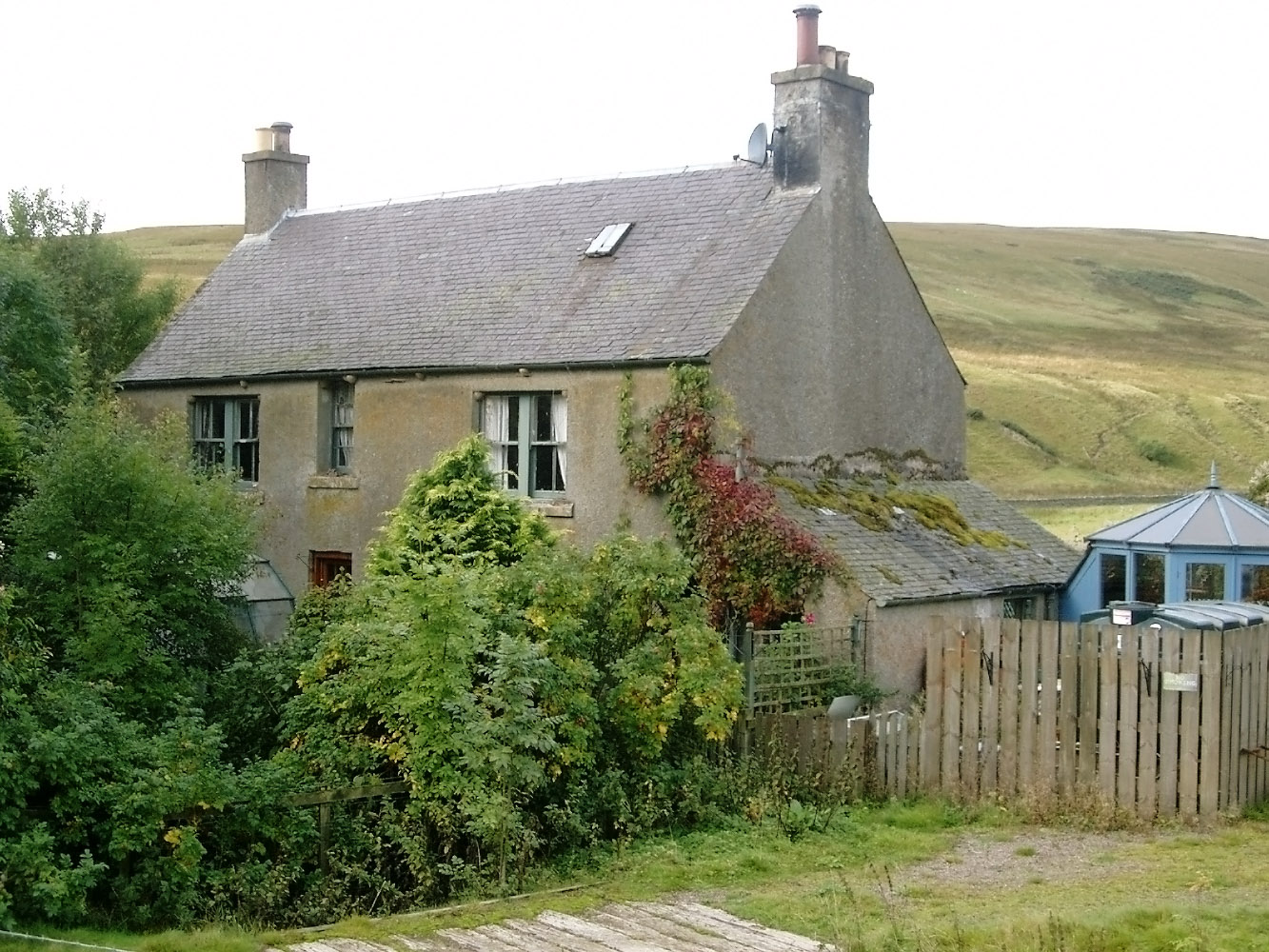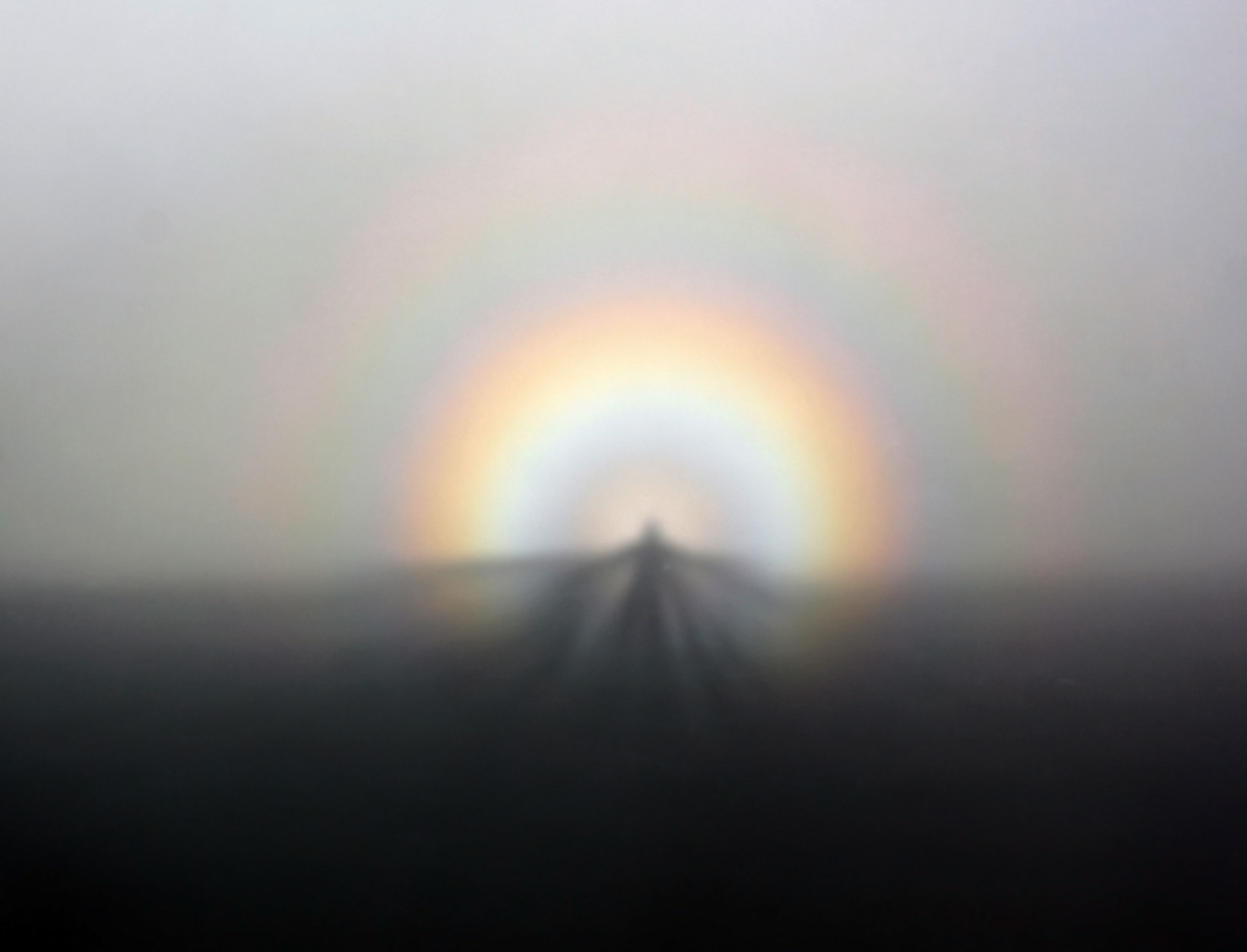|
Am Fear Liath Mòr
In Scottish folklore, Am Fear Liath Mòr (; ; also known as the Big Grey Man of Ben MacDhui or simply the Greyman) is the name for a presence or creature which is said to haunt the summit and passes of Ben Macdui, the highest peak of the Cairngorms and the second highest peak in British Isles after Ben Nevis. Description Although there have been many purported encounters with the Big Grey Man, few eyewitnesses have actually seen the creature. It is reported to be very thin and over ten feet tall, with dark skin and hair, long arms, and broad shoulders. Most often, the creature remains unseen in the fog of the mountain, with encounters limited to the sound of crunching gravel as it walks behind climbers and a general feeling of unease around the mountain. Tangible evidence of its existence is limited to a few photographs of unusual footprints, so the majority relies on the credibility of eyewitness encounters. Sightings In 1925, J. Norman Collie gave the first recorded account o ... [...More Info...] [...Related Items...] OR: [Wikipedia] [Google] [Baidu] |
Scottish Folklore
Scottish folklore (Scottish Gaelic: ''Beul-aithris na h-Alba'') encompasses the folklore of the Scottish people from their earliest records until today. Folklorists, both academic and amateur, have published a variety of works focused specifically on the area over the years.Sanderson (1957: 457-466). Some creatures of Scottish folklore are Loch Ness Monster, brownies, bogles, kelpies, selkies, the wulver, the bean-nighe and the blue men of the Minch. Notes References * See also *Cornish mythology *English folklore *Matter of Britain *Welsh folklore *Welsh mythology Welsh mythology (Welsh: ''Mytholeg Cymru'') consists of both folk traditions developed in Wales, and traditions developed by the Celtic Britons elsewhere before the end of the first millennium. As in most of the predominantly oral societies Cel ... * Scottish mythology External links *Scottish Folk Tales(en) {{Folklore-stub ... [...More Info...] [...Related Items...] OR: [Wikipedia] [Google] [Baidu] |
Solitude
Solitude is a state of seclusion or isolation, meaning lack of socialisation. Effects can be either positive or negative, depending on the situation. Short-term solitude is often valued as a time when one may work, think, or rest without disturbance. It may be desired for the sake of privacy. Undesirable long-term solitude may stem from soured relationships, loss of loved ones, deliberate choice, infectious disease, mental disorders, neurological disorders such as circadian rhythm sleep disorder, or circumstances of employment or situation. A distinction has been made between solitude and loneliness. In this sense, these two words refer, respectively, to the joy and the pain of being alone. Health effects Symptoms from complete isolation, called sensory deprivation, may include anxiety, sensory illusions, or distortions of time and perception. However, this is the case when there is no stimulation of the sensory systems at all and not just lack of contact with people. Thus, ... [...More Info...] [...Related Items...] OR: [Wikipedia] [Google] [Baidu] |
Fantasy Creatures
Fantasy is a genre of speculative fiction involving magical elements, typically set in a fictional universe and sometimes inspired by mythology and folklore. Its roots are in oral traditions, which then became fantasy literature and drama. From the twentieth century, it has expanded further into various media, including film, television, graphic novels, manga, animations and video games. Fantasy is distinguished from the genres of science fiction and horror by the respective absence of scientific or macabre themes, although these genres overlap. In popular culture, the fantasy genre predominantly features settings that emulate Earth, but with a sense of otherness. In its broadest sense, however, fantasy consists of works by many writers, artists, filmmakers, and musicians from ancient myths and legends to many recent and popular works. Traits Most fantasy uses magic or other supernatural elements as a main plot element, theme, or setting. Magic, magic practitioners ( so ... [...More Info...] [...Related Items...] OR: [Wikipedia] [Google] [Baidu] |
Fairies
A fairy (also fay, fae, fey, fair folk, or faerie) is a type of mythical being or legendary creature found in the folklore of multiple European cultures (including Celtic, Slavic, Germanic, English, and French folklore), a form of spirit, often described as metaphysical, supernatural, or preternatural. Myths and stories about fairies do not have a single origin, but are rather a collection of folk beliefs from disparate sources. Various folk theories about the origins of fairies include casting them as either demoted angels or demons in a Christian tradition, as deities in Pagan belief systems, as spirits of the dead, as prehistoric precursors to humans, or as spirits of nature. The label of ''fairy'' has at times applied only to specific magical creatures with human appearance, magical powers, and a penchant for trickery. At other times it has been used to describe any magical creature, such as goblins and gnomes. ''Fairy'' has at times been used as an adjective, with a m ... [...More Info...] [...Related Items...] OR: [Wikipedia] [Google] [Baidu] |
Aos Sí
' (; older form: ) is the Irish name for a supernatural race in Celtic mythology – spelled ''sìth'' by the Scots, but pronounced the same – comparable to fairies or elves. They are said to descend from either fallen angels or the Tuatha Dé Danann, meaning the "People of Danu", depending on the Abrahamic or pagan tradition. The ''aos sí'' are said to live underground in fairy forts, across the Western sea, or in an invisible world that co-exists with the world of humans. This world is described in the ''Lebor Gabála Érenn'' as a parallel universe in which the ''aos sí'' walk among the living. In modern Irish the people of the mounds are also called ''daoine sí''; in Scottish Gaelic they are called ''daoine sìth'' (in both cases, it means "people of the fairy mound"). They are variously said to be the ancestors, the spirits of nature, or goddesses and gods. Evans Wentz, W. Y. (1966, 1990The Fairy-Faith in Celtic Countries Gerrards Cross, Colin Smythe Humanitie ... [...More Info...] [...Related Items...] OR: [Wikipedia] [Google] [Baidu] |
Lubber Fiend
The lubber fiend, Lob, lubberkin, lurdane or Lob Lie-By-The-Fire is a legendary creature of English folklore that is similar to the " brownie" (or "Urisk") of Scotland and northern England, the " hob" of northern England and the Scottish Borders, the Slavic "domovoi" and Scandinavian "tomte". It has been related also to Robin Goodfellow, and Hobgoblins. It is best known for being mentioned by John Milton. The lubberkin is typically described as a large, hairy man with a tail who performs housework in exchange for a saucer of milk and a place in front of the fire. One story claims he is the giant son of a witch and the Devil. The abbey lubber is a minor demon that haunts the wine cellars and kitchens of abbeys, tempting the monks into drunkenness, gluttony and lasciviousness. The best known abbey lubber tale is that of Friar Rush. Briggs, Katharine (1976). ''An Encyclopedia of Fairies''. Pantheon Books. p. 1. . Lubber fiend in literature The lubber fiend appears also in '' T ... [...More Info...] [...Related Items...] OR: [Wikipedia] [Google] [Baidu] |
Wild Man
The wild man, wild man of the woods, or woodwose/wodewose is a mythical figure that appears in the art and literature of medieval Europe, comparable to the satyr or faun type in classical mythology and to '' Silvanus'', the Roman god of the woodlands. The defining characteristic of the figure is its "wildness"; from the 12th century, they were consistently depicted as being covered with hair. Images of wild men appear in the carved and painted roof bosses where intersecting ogee vaults meet in Canterbury Cathedral, in positions where one is also likely to encounter the vegetal Green Man. The image of the wild man survived to appear as supporter for heraldic coats-of-arms, especially in Germany, well into the 16th century. Renaissance engravers in Germany and Italy were particularly fond of wild men, wild women, and wild families, with examples from Martin Schongauer (died 1491) and Albrecht Dürer (1471–1528) among others. Terminology The normal Middle English term, also use ... [...More Info...] [...Related Items...] OR: [Wikipedia] [Google] [Baidu] |
Frank Smythe
Francis Sydney Smythe, better known as Frank Smythe or F. S. Smythe (6 July 1900 – 27 June 1949), was an English mountaineer, author, photographer and botanist. He is best remembered for his mountaineering in the Alps as well as in the Himalayas, where he identified a region that he named the "Valley of Flowers", now a protected park. His ascents include two new routes on the Brenva Face of Mont Blanc, Kamet, and attempts on Kangchenjunga and Mount Everest in the 1930s. It was said that he had a tendency for irascibility, something some of his mountaineering contemporaries said "decreased with altitude". Biography Smythe was born at Maidstone in Kent and educated in Switzerland after an initial period at Berkhamsted School. He trained as an electrical engineer and worked for brief periods with the Royal Air Force and Kodak before devoting himself to writing and public lecturing. Smythe enjoyed mountaineering, photography, collecting plants, and gardening; he toured as a lec ... [...More Info...] [...Related Items...] OR: [Wikipedia] [Google] [Baidu] |
James Hogg
James Hogg (1770 – 21 November 1835) was a Scottish poet, novelist and essayist who wrote in both Scots and English. As a young man he worked as a shepherd and farmhand, and was largely self-educated through reading. He was a friend of many of the great writers of his day, including Sir Walter Scott, of whom he later wrote an unauthorised biography. He became widely known as the "Ettrick Shepherd", a nickname under which some of his works were published, and the character name he was given in the widely read series '' Noctes Ambrosianae'', published in ''Blackwood's Magazine''. He is best known today for his novel ''The Private Memoirs and Confessions of a Justified Sinner''. His other works include the long poem '' The Queen's Wake'' (1813), his collection of songs ''Jacobite Relics'' (1819), and his two novels ''The Three Perils of Man'' (1822), and ''The Three Perils of Woman'' (1823). Biography Early life James Hogg was born on a small farm near Ettrick, Selkirkshire, ... [...More Info...] [...Related Items...] OR: [Wikipedia] [Google] [Baidu] |
New Scientist
''New Scientist'' is a magazine covering all aspects of science and technology. Based in London, it publishes weekly English-language editions in the United Kingdom, the United States and Australia. An editorially separate organisation publishes a monthly Dutch-language edition. First published on 22 November 1956, ''New Scientist'' has been available in online form since 1996. Sold in retail outlets (paper edition) and on subscription (paper and/or online), the magazine covers news, features, reviews and commentary on science, technology and their implications. ''New Scientist'' also publishes speculative articles, ranging from the technical to the philosophical. ''New Scientist'' was acquired by Daily Mail and General Trust (DMGT) in March 2021. History Ownership The magazine was founded in 1956 by Tom Margerison, Max Raison and Nicholas Harrison as ''The New Scientist'', with Issue 1 on 22 November 1956, priced at one shilling (a twentieth of a pound in pre-decimal UK cu ... [...More Info...] [...Related Items...] OR: [Wikipedia] [Google] [Baidu] |
BBC News Online
BBC News Online is the website of BBC News, the division of the BBC responsible for newsgathering and production. It is one of the most popular news websites, with 1.2 billion website visits in April 2021, as well as being used by 60% of the UK's internet users for news. The website contains international news coverage, as well as British, entertainment, science, and political news. Many reports are accompanied by audio and video from the BBC's television and radio news services, while the latest TV and radio bulletins are also available to view or listen to on the site together with other current affairs programmes. BBC News Online is closely linked to its sister department website, that of BBC Sport. Both sites follow similar layout and content options and respective journalists work alongside each other. Location information provided by users is also shared with the website of BBC Weather to provide local content. From 1998 to 2001 the site was named best news website at t ... [...More Info...] [...Related Items...] OR: [Wikipedia] [Google] [Baidu] |
Brocken Spectre
A Brocken spectre (British English; American spelling Brocken specter; german: Brockengespenst), also called Brocken bow, mountain spectre, or spectre of the Brocken is the magnified (and apparently enormous) shadow of an observer cast in mid air upon any type of cloud opposite a strong light source. Additionally, if the cloud consists of water droplets backscattered, a bright area called , and halo-like rings of rainbow coloured light called a glory can be seen around the head or apperature silhouette of the spectre. Typically the spectre appears in sunlight opposite the sun's direction at the antisolar point. The phenomenon can appear on any misty mountainside, cloud bank, or be seen from an aircraft, but the frequent fogs and low-altitude accessibility of the Brocken, a peak in the Harz Mountains in Germany, have created a local legend from which the phenomenon draws its name. The Brocken spectre was observed and described by Johann Silberschlag in 1780, and has often been r ... [...More Info...] [...Related Items...] OR: [Wikipedia] [Google] [Baidu] |


_(14730388126).jpg)

.jpg)



